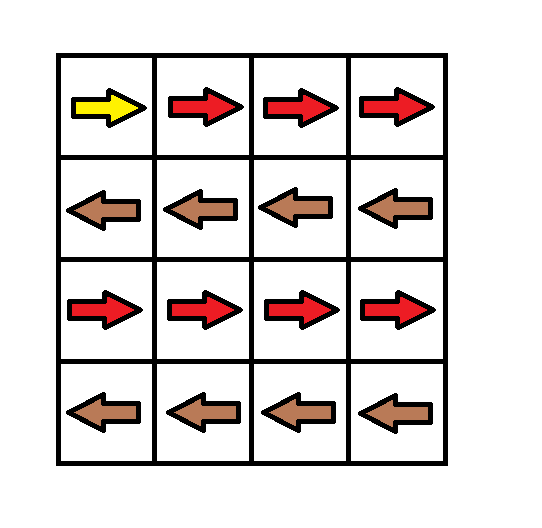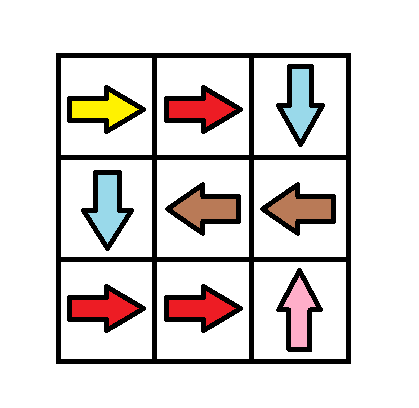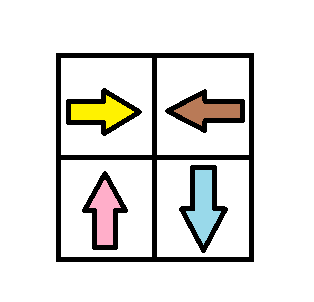- {x}
- Number of Days Between Two Dates
- Validate Binary Tree Nodes
- Closest Divisors
- Largest Multiple of Three
- Number of Trusted Contacts of a Customer
- How Many Numbers Are Smaller Than the Current Number
- Rank Teams by Votes
- Linked List in Binary Tree
- Minimum Cost to Make at Least One Valid Path in a Grid
- Get the Second Most Recent Activity
- Increasing Decreasing String
- Find the Longest Substring Containing Vowels in Even Counts
- Longest ZigZag Path in a Binary Tree
- Maximum Sum BST in Binary Tree
- Generate a String With Characters That Have Odd Counts
- Number of Times Binary String Is Prefix-Aligned
- Time Needed to Inform All Employees
- Read More...

Minimum Cost to Make at Least One Valid Path in a Grid
Given an m x n grid. Each cell of the grid has a sign pointing to the next cell you should visit if you are currently in this cell. The sign of grid[i][j] can be:
1which means go to the cell to the right. (i.e go fromgrid[i][j]togrid[i][j + 1])2which means go to the cell to the left. (i.e go fromgrid[i][j]togrid[i][j - 1])3which means go to the lower cell. (i.e go fromgrid[i][j]togrid[i + 1][j])4which means go to the upper cell. (i.e go fromgrid[i][j]togrid[i - 1][j])
Notice that there could be some signs on the cells of the grid that point outside the grid.
You will initially start at the upper left cell (0, 0). A valid path in the grid is a path that starts from the upper left cell (0, 0) and ends at the bottom-right cell (m - 1, n - 1) following the signs on the grid. The valid path does not have to be the shortest.
You can modify the sign on a cell with cost = 1. You can modify the sign on a cell one time only.
Return the minimum cost to make the grid have at least one valid path.
Example 1:

Input: grid = [[1,1,1,1],[2,2,2,2],[1,1,1,1],[2,2,2,2]] Output: 3 Explanation: You will start at point (0, 0). The path to (3, 3) is as follows. (0, 0) --> (0, 1) --> (0, 2) --> (0, 3) change the arrow to down with cost = 1 --> (1, 3) --> (1, 2) --> (1, 1) --> (1, 0) change the arrow to down with cost = 1 --> (2, 0) --> (2, 1) --> (2, 2) --> (2, 3) change the arrow to down with cost = 1 --> (3, 3) The total cost = 3.
Example 2:

Input: grid = [[1,1,3],[3,2,2],[1,1,4]] Output: 0 Explanation: You can follow the path from (0, 0) to (2, 2).
Example 3:

Input: grid = [[1,2],[4,3]] Output: 1
Constraints:
m == grid.lengthn == grid[i].length1 <= m, n <= 1001 <= grid[i][j] <= 4
Solution Explanation: Minimum Cost to Make at Least One Valid Path in a Grid
This problem asks for the minimum cost to modify the directions in a grid to create at least one valid path from the top-left corner (0,0) to the bottom-right corner (m-1, n-1). The cost of changing a direction is 1.
Approach:
The optimal approach is using a variation of Breadth-First Search (BFS) with a deque (double-ended queue). A standard BFS wouldn't be efficient enough because it doesn't prioritize exploring paths that require fewer changes.
-
Initialization:
- We start at
(0, 0)with a cost of 0. - We use a
dequeto store the cells to visit. The deque allows us to add elements to both ends, which is crucial for efficiency. - A
visitedset keeps track of cells we've already explored to avoid cycles.
- We start at
-
BFS with Deque:
- The
dequeis prioritized. Cells reachable without changing direction (cost 0) are added to the front of the deque. Cells requiring a direction change (cost 1) are added to the back. This ensures that we explore paths with fewer direction changes first. - During each iteration, we:
- Dequeue a cell
(i, j)from the front of thedeque. - If the cell is already visited, continue.
- Mark the cell as visited.
- If we reach the target cell
(m-1, n-1), return the current costd. - Explore all four possible directions (up, down, left, right) from
(i, j):- If the direction matches the existing direction in the grid, add the neighboring cell to the front of the deque (cost 0).
- If the direction does not match, add the neighboring cell to the back of the deque (cost 1, incrementing the cost
d).
- Dequeue a cell
- The
-
Handling Out-of-Bounds: We need to check that the next cell is within the bounds of the grid before processing it.
-
No Valid Path: If the
dequebecomes empty before reaching the target cell, it means there is no valid path, and we can return -1 (though the problem statement implies there will always be a solution).
Time Complexity: O(M*N), where M and N are the dimensions of the grid. In the worst case, we visit each cell once.
Space Complexity: O(M*N), in the worst case, we store all cells in the deque and visited set.
Code (Python):
from collections import deque
def minCost(grid):
m, n = len(grid), len(grid[0])
dirs = [(0, 1), (0, -1), (1, 0), (-1, 0)] # Right, Left, Down, Up
q = deque([(0, 0, 0)]) # (row, col, cost)
visited = set()
while q:
row, col, cost = q.popleft()
if (row, col) in visited:
continue
visited.add((row, col))
if row == m - 1 and col == n - 1:
return cost
for i, (dr, dc) in enumerate(dirs):
next_row, next_col = row + dr, col + dc
if 0 <= next_row < m and 0 <= next_col < n:
new_cost = cost + (i + 1 != grid[row][col]) #Increment cost if direction change is needed
if (i+1) == grid[row][col]:
q.appendleft((next_row, next_col, new_cost))
else:
q.append((next_row, next_col, new_cost))
return -1 # Should not reach here based on problem statement
The code in other languages (Java, C++, Go, TypeScript) follows the same logic, using their respective deque implementations and data structures. The core algorithm remains consistent.